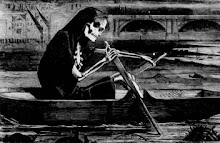 For various weak and not-worth-recounting reasons, I didn't make it to the Monterey Historics at Laguna Seca this year, but I wish I had. There was one car that I'd love to have seen in action that I haven't had the privilege of seeing run for almost 30 years.
For various weak and not-worth-recounting reasons, I didn't make it to the Monterey Historics at Laguna Seca this year, but I wish I had. There was one car that I'd love to have seen in action that I haven't had the privilege of seeing run for almost 30 years.
Yesterday was a glorious day, and on the track were some unique race cars not seen in previous years that I wasn't aware in advance would be there. Chief amongst those for me was the 6 wheel Tyrrell P34. Not exactly sure which chassis it was but the livery was the right colour (blue all over) for the 1976 season and the car was wearing number 4, so I think that was Patrik Depailler's ride for that year.
(At the time of writing, D.M. Troutman had posted the first shots in a gallery from Saturday and the Tyrrell is on slide 63. Some very good shots in here and the gallery reinforces just what a great day it must have been. Note the shots of Mario Andretti in a period Lotus JPS!)
This design was a brilliant piece of lateral thinking: smaller wheels = less frontal area = reduced drag, but then how to make up for the now-reduced contact patch? Have four front wheels instead of two, of course! And despite the added mechanical complexity, it actually worked pretty well, leading to a couple of other teams starting to look along the same lines. Alas, because it required special tyres and rims,there wasn't the same level of tyre development for this configuration as there was for the more conventional approach, and other solutions were being found to reduce frontal area cross-section. Tyrrell redesigned the car for 1977, adding weight and further complexity, a strategy that works for OK road cars but not so well for racing machinery. Ronnie Peterson took over driving duties at Tyrrell from Scheckter but by then it was clear that this was now an engineering dead-end, leading to its overall demise by the start of the 1978 season.
As a result, Jody Scheckter is still the only driver in history to win a race in a six-wheeled car, and given that these days investments into other technologies - especially wind tunnel based aerodynamic testing and exotic suspension materials & design - have rendered such innovative mechanical solutions to the problem of front-end aero resistance largely obsolete then he's likely to remain so. Oh, and just in case there was any doubt then it's worth mentioning that the arbiters of F1 declared that race cars should have a maximum of four wheels after Williams tested another six wheel design in the early 80s, though this time with the much smarter configuration of 4 at the rear, that provided significant extra grip and in a place where the aero effect was easily managed and you didn't have to figure out how to steer the bloody things.
Of course, that begs the question of whether or not three wheeled design could ever work well enough to get raced, which holds out hope for the old Reliant Robin I suppose. Though not much ....


No comments:
Post a Comment